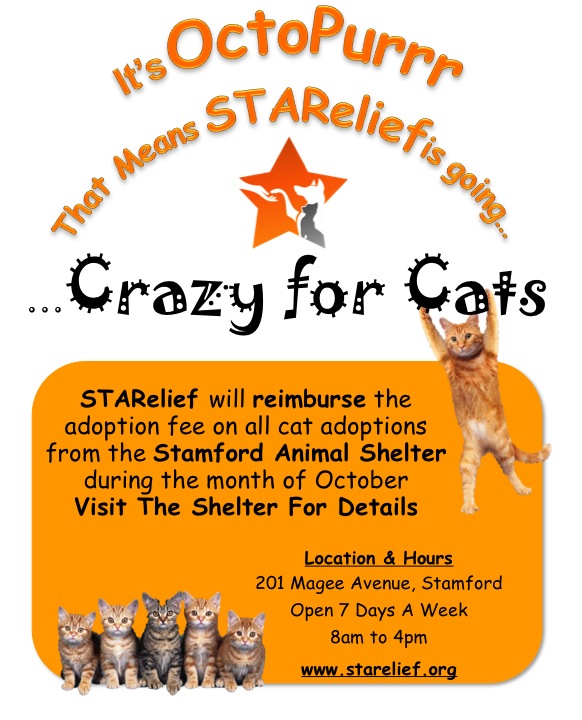
Join The Fun, Save a Life, and Support STARelief and Pet Assistance
Dog Wash – Free Rabies & Microchip Clinic – DIY Agility Course – Balloon Bust –
Ask The Vet – Stamford Police Dog Demonstration – And Much More
2017 Sponsors

Join The Fun, Save a Life, and Support STARelief and Pet Assistance
Dog Wash – Free Rabies & Microchip Clinic – DIY Agility Course – Balloon Bust –
Ask The Vet – Stamford Police Dog Demonstration – And Much More
2017 Sponsors
Join us for an evening of Holiday Cheer & Shopping on November 30th! Special Guest: Celebrity Petographer, Jim Dratfield’s Petography will be signing his latest book “The Love of a Lab”. Proceeds will benefit our local safe pet fostering program at STARelief and Pet Assistance, a non profit that supports the pets of those in need.
Jim Dratfield will also be featuring his work and donating one of his framed pet photographs.
Special Gift Items Include: Harry Barker, the Thymes Home Collection, Archipelago Candles and Spa Line, Jewelry, Scarves, Wraps, Home Accessories, Oribe and R&Co Hair Care Products.
Few things are as exciting as bringing home a new pet. At least for you. But how do you imagine the big introduction between your new dog and your resident pet(s)? Do you imagine handing out treats and name tags at your front door, resulting in happy munches and friendly woofs (or meows) as they bond instantly and forever. Cesar Millan would be so proud.
Then you blink twice and remember that you are living in reality and not in some ideal parallel universe. But reality can match your ideal, when you’re armed with these nine easy to follow steps, and a healthy dose of reality.
Hopefully, when you’re ready to make the “formal” introductions, your patience and your animals’ pre-preparations will pay off. And they will not only recognize, but also start to accept one another by what they see and smell.
Once again, patience is key. This too is a process, which may take time until the blending is successful, and your family is calmly and contentedly one.
If, however, certain problems persist, speak to your vet or consult a recommended animal behaviorist.
Some additional resources on introducing new dogs to your existing pet family may be found on Cesar’s Way Blog and the Humane Society.
Don’t be caught without an emergency plan for your pets! Join us for our first Pet Preparedness and First Aid Class on May 3, 2015 from 2-4pm.
Like many cat owners, you may be fed up with finding scratch marks on everything from your floors and furniture to your curtains and comforters, cushions and clothes. And skin. But before you consider resolving the problem by choosing declawing as your only solution, be advised that declawing your cat is NOT a matter of solely removing its claws. Nor is it as simple a procedure as a manicure, or in this case, a pedicure.
In fact, it is a serious SURGICAL procedure that requires a general anesthetic. Commonly referred to as onychectomy, implying that only the claw is removed, the more appropriate term should be phalangectomy, which refers to the excision of the toe bone itself. Why? Because a cat’s claw, unlike a toenail, adheres so closely to the bone that to remove the claws on a single foot is to remove the last bone of all five toes. In other words: amputation. Not only is the operation itself extremely painful, but so is the protracted period of recovery. If “recovery” is even the proper word.
A cat’s body is uniquely designed, allowing it to move with agility and grace, and its claws are an integral part of that design. Amputating so vital a part of their anatomy drastically alters the conformation of their feet, and since cats walk on their toes, this surgery actually changes the way their bodies work. Because of this, their back and leg muscles may weaken over time, potentially leading to chronic back and joint pain. Other complications from the procedure may include postoperative hemorrhage, nerve damage, and displaced bone chips that prevent proper healing. Post-operative care can be complicated and difficult, both for you and your cat.
Because a declawed cat must wear bandages on its paws until the incisions heal, exercise must be limited for at least one month and cat litter replaced with shredded newspaper to keep litter granules from embedding themselves in the healing tissue. Your vet may prescribe medications to help with the pain, and you must monitor your cat carefully for swollen paws, bleeding and a reluctance to walk, as well as any changes in appetite and behavior. While some cats exhibit no changes in personality after being declawed, others may become anxious, shy, or show an increase in aggression. Feeling defenseless without their claws may cause them to bite if they feel cornered. And the pain associated with the procedure may result in urinating and defecating outside the litter box.
Because scratching is as innate to cats as purring, most experts recommend other alternatives to the trauma and dangers of declawing. Keep your cat’s nails carefully trimmed and direct its scratching behavior to inexpensive cardboard scratchers, scratching posts or emery scratching pads that dull its claws. Use remote aversion devices such as Scat Mats. But if all else fails, the newest and most popular alternative to declawing is the application of vinyl nail caps, available through your veterinarian or pet store. Non-toxic glue binds the caps to the claws, and the caps are replaced when your cat sheds its claw sheaths (usually every four to six weeks).
While declawing remains peculiar to the United States, an ever-increasing number of countries throughout the world consider it both “inhumane” and a “form of mutilation” (except in the most extreme cases or for medical reasons) and have banned the procedure. In fact, a global online campaign declared March 29, 2014 as Declaw Awareness Day.
What are your thoughts on Declawing? Let us know in the comments section of this blog!
————————————————————————————————————————————————————-
Article by Nomi Berger
Nomi is the best selling author of seven novels, one work of non-fiction, two volumes of poetry and hundreds of articles. She lives in Toronto, Ontario, Canada with her adopted Maltese, Mini, and now devotes all of her time volunteering her writing skills to animal rescue organizations throughout Canada and the USA.

